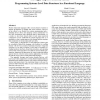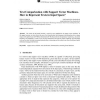1715 search results - page 1 / 343 » How Space Structures Language |
SPATIALCOGNITION
1998
Springer
13 years 9 months ago
1998
Springer
As Talmy has observed, language schematizes space; language provides a systematic framework to describe space, by selecting certain aspects of a referent scene while neglecting the...
ACL
1994
13 years 6 months ago
1994
This paper shows how to formally characterize language learning in a finite parameter space as a Markov structure, hnportant new language learning results follow directly: explici...
HASKELL
2006
ACM
13 years 10 months ago
2006
ACM
Modern functional languages offer several attractive features to support development of reliable and secure software. However, in our efforts to use Haskell for systems programmin...
ML
2002
ACM
13 years 4 months ago
2002
ACM
The choice of the kernel function is crucial to most applications of support vector machines. In this paper, however, we show that in the case of text classification, term-frequenc...
ACL
2007
13 years 6 months ago
2007
A Bloom filter (BF) is a randomised data structure for set membership queries. Its space requirements are significantly below lossless information-theoretic lower bounds but it ...


